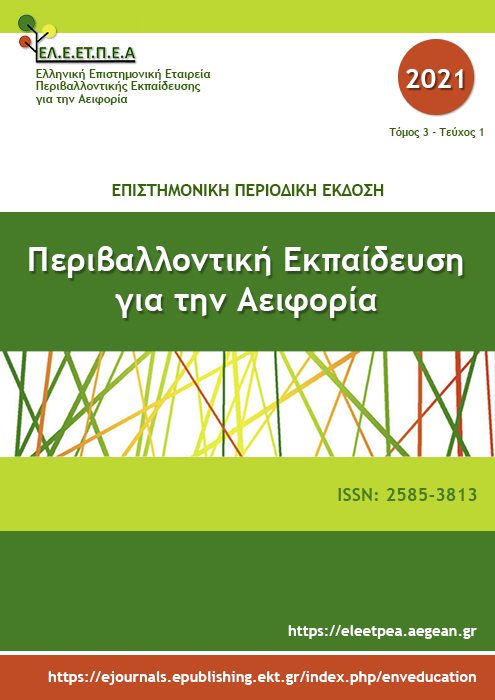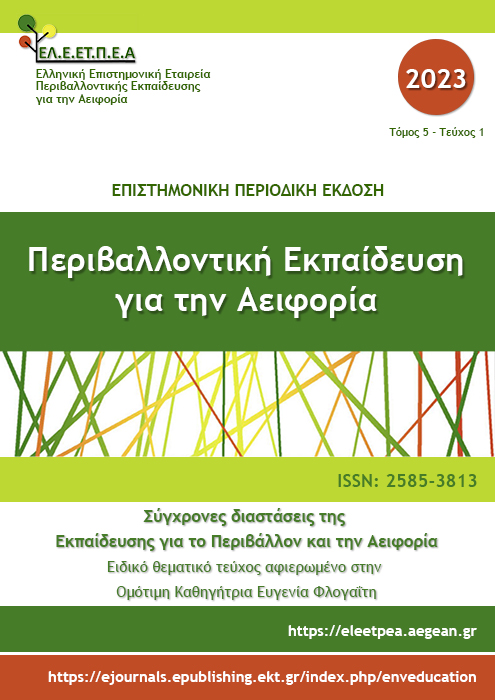Ανιχνεύοντας τις ενδείξεις δημιουργικότητας των παιδιών του νηπιαγωγείου στο πλαίσιο της Προσχολικής Εκπαίδευσης για την Αειφορία
Abstract
Η δημιουργικότητα αναγνωρίζεται διεθνώς ως μια ικανότητα-κλειδί την οποία χρειάζεται να αναπτύξει ο άνθρωπος, ώστε να ανταποκρίνεται στις προκλήσεις του σύγχρονου κόσμου. Ωστόσο, η σχέση της έννοιας με την εκπαίδευση παραμένει ένα πεδίο αρκετά ασαφές, με λιγοστά εμπειρικά δεδομένα που να τεκμηριώνουν πώς εκδηλώνεται, πώς νοηματοδοτείται και πώς αποτιμάται στο εκπαιδευτικό πλαίσιο. Επιπλέον, ελάχιστες ερευνητικές αναφορές μελετούν ειδικά τη σχέση της δημιουργικότητας και της δημιουργικής σκέψης των μαθητών με την Περιβαλλοντική Εκπαίδευση /Εκπαίδευση για την Αειφόρο Ανάπτυξη. Η παρούσα εργασία βασίζεται σε μια έρευνα-δράση διάρκειας ενός σχολικού έτους, η οποία πραγματοποιήθηκε από την εκπαιδευτικό μιας τάξης νηπιαγωγείου της Αττικής και εξέτασε τη δημιουργικότητα των μαθητών στο πλαίσιο της Προσχολικής Εκπαίδευσης για την Αειφορία. Ειδικότερα, εστιάζει στις ενδείξεις της δημιουργικής σκέψης των παιδιών, οι οποίες εκδηλώθηκαν κατά τη διάρκεια διεξαγωγής μιας εκπαιδευτικής παρέμβασης με όχημα την τέχνη, με σκοπό την προσέγγιση ενός περιβαλλοντικού ζητήματος.
Article Details
- Zitationsvorschlag
-
Καλαφάτη Μ. (2021). Ανιχνεύοντας τις ενδείξεις δημιουργικότητας των παιδιών του νηπιαγωγείου στο πλαίσιο της Προσχολικής Εκπαίδευσης για την Αειφορία. Περιβαλλοντική Εκπαίδευση για την Αειφορία, 3(1), 17–37. https://doi.org/10.12681/ees.25542
- Rubrik
- Articles

Dieses Werk steht unter der Lizenz Creative Commons Namensnennung - Nicht-kommerziell - Weitergabe unter gleichen Bedingungen 4.0 International. Οι συγγραφείς διατηρούν τα πνευματικά δικαιώματα και παρέχουν στο περιοδικό το δικαίωμα της πρώτης δημοσίευσης μαζί με την αδειοδότηση της εργασίας με CC-BY-NC-SA, που επιτρέπει σε άλλους να μοιράζονται αυτή την εργασία με αναγνώριση του συγγραφικού δικαιώματος και την αρχική δημοσίευση σε αυτό το περιοδικό.




